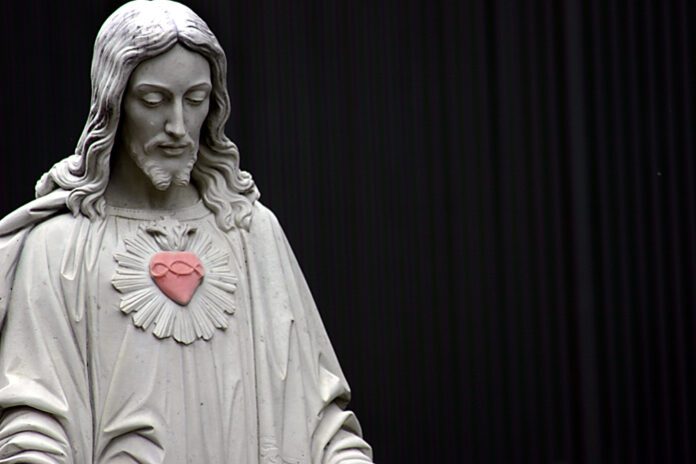The month of June is dedicated to the Sacred Heart of Jesus. From 1673 to 1675, Jesus appeared to St. Margaret Mary Alacoque in France, and emphasized his deep love and compassion for humanity, emotions that are embodied in the image of his Sacred Heart. In this message and image, Jesus emphasizes the passion and emotion that we can forget he has. The month of the Sacred Heart is also an invitation to reconsider the fullness of who Jesus is and also what he is not.
Jesus Christ is the eternal second Person of the Holy Trinity. He took upon himself a full, complete, and perfect human nature when he was conceived in Mary’s womb. From that point on, Jesus is always fully God and fully man, God incarnate, God in flesh. Within his own Person, he has brought God and man together. He is one divine Person with two complete natures, one human and one divine. Over the centuries, the Church has refined her terminology, often by borrowing philosophical terminology, to more fully explain this mystery in the face of various misunderstandings and false teaching, now known as christological heresies. These heresies sometimes creep into our own view of who Jesus is.
The earliest heresies often denied that Jesus was really human at all. Docetism claimed he didn’t even have a real body, while the Church insisted that Jesus is God “in the flesh” (1 John 4:2). Arianism posited that Jesus is not really God but is an elevated human being, a demigod of sorts, created from a non-divine nature. Against this, the Church calls Jesus “consubstantial with the Father” (Nicene Creed). Nestorianism claimed that Jesus is two persons united together, rendering him some sort of mixture of the two. The Church clarified with Marian terminology, stating that Mary of Nazareth is not just the mother of Jesus’ human nature or even the Mother of Christ but that she is truly the Mother of God. Monophysitism claimed Jesus’ divine nature absorbed and in a sense destroyed his human nature in the incarnation, leaving him with one nature, not two. The Church clarified that Jesus is “two natures without confusion, change, division, or separation” and that his two natures “came together in one person” (Council of Chalcedon). Later heresies diminished Jesus’ human nature to be essentially a tool of his divine nature, and so the Church reaffirmed that Jesus is only one Person (Second Council of Constantinople), meaning that everything in his human nature is to be attributed to his divine Person.
Jesus is inseparably fully God and fully man united in one divine Person. What can be attributed to his divine nature (eternity, omnipotence, omniscience, etc.) is also attributed to him personally. What can be attributed to his human nature (suffering, death, human emotions, etc.) is also attributed to him personally. Jesus perfectly and eternally loves the Father in union with the Spirit and perfectly and eternally loves every human being, you and me, with the same Sacred Heart. In celebrating the Sacred Heart of Jesus, we are reminded of Jesus’ full and sacred humanity, which includes both a metaphorical heart to be the seat of his emotions and a physical heart for pumping his precious blood throughout his sacred body.
When we receive the Eucharist, we receive Jesus’ Body, Blood, Soul–that is to say his full, complete, and perfect humanity–and his Divinity. We become “partakers of the divine nature” (1 Peter 1:3) and also partakers of perfect human nature. We consume him so as to become more and more like him, a union of humanity and divinity. His union is hypostatic, two natures fully and perfectly united in one Person without confusion or absorbtion. Our union is adoptive, evermore perfecting our human nature through the grace of God to evermore perfectly participate in the life of the Trinity into which Jesus brought his perfect human nature. The Church calls this process deification or sanctification. We are deified, not turned into deities ourselves but drawn up into the very life of the triune deity.
This month of the Sacred Heart of Jesus invites us to consider ever more deeply this mystery of the incarnation. God took on flesh, took on a beating heart, in order to elevate our flesh. May our hearts beat ever more in sync with his, and may we praise him ever more perfectly with every beat of our hearts.

